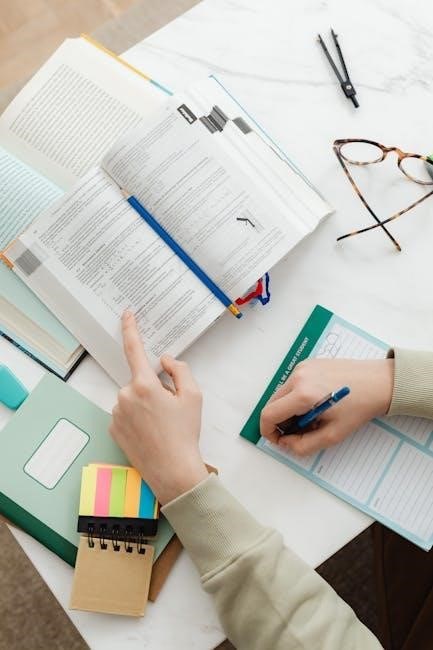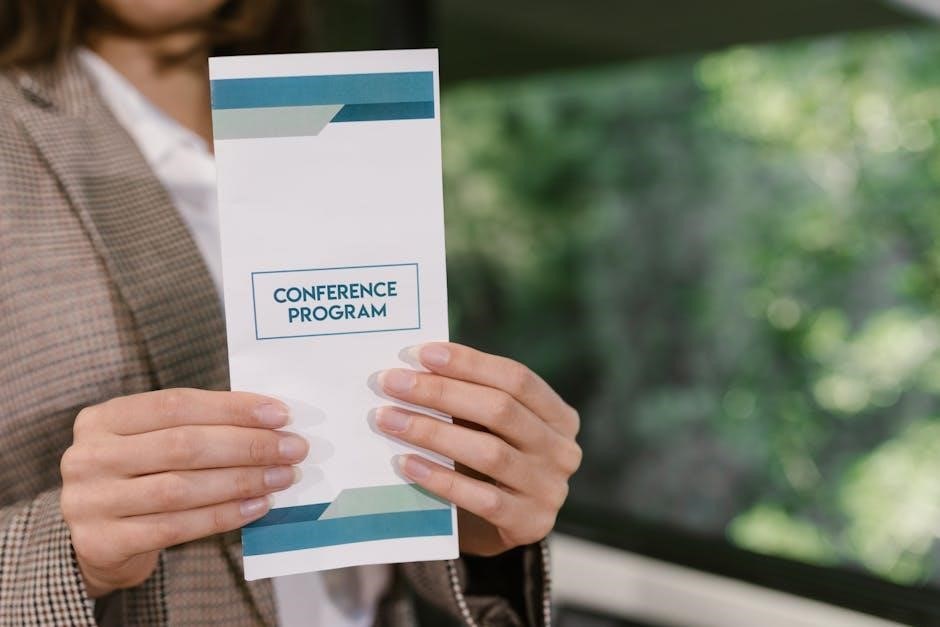Guided reading questions are instructional tools designed to engage students deeply with texts‚ fostering comprehension and critical thinking. They play a crucial role in educational settings‚ enhancing learning effectiveness and student engagement through structured inquiry.
1.1 What Are Guided Reading Questions?
Guided reading questions are carefully crafted inquiries designed to direct students’ attention and thinking during reading activities. These questions‚ typically prepared by educators‚ are intended to guide learners through texts‚ helping them focus on key details‚ themes‚ and concepts. They are structured to encourage active engagement‚ comprehension‚ and analysis‚ ensuring students derive meaningful insights from the material. Unlike open-ended discussions‚ guided questions provide a clear framework‚ making them especially useful for students developing their reading skills. By addressing various cognitive levels‚ these questions cater to diverse learning needs‚ promoting a deeper understanding and appreciation of the text.
1.2 Overview of Guided Reading
Guided reading is an instructional approach that involves teachers working with small groups of students to read and interpret texts. It combines modeling‚ coaching‚ and questioning to support learners in developing reading proficiency. Guided reading sessions typically include a pre-reading discussion‚ reading aloud with teacher guidance‚ and post-reading reflection. This method allows educators to cater to diverse reading levels by selecting texts that align with students’ abilities and providing scaffolding as needed. The goal is to build independence‚ fluency‚ and comprehension skills while fostering a deeper connection to the material. It is a flexible and effective strategy for teaching reading across various age groups and skill levels.

Importance of Guided Reading Questions
Guided reading questions are essential for fostering engagement‚ deeper understanding‚ and analytical skills‚ helping students connect with texts on multiple levels.
2.1 Enhancing Reading Comprehension
Guided reading questions are designed to improve students’ ability to understand and interpret texts effectively. They focus on key details‚ main ideas‚ and the author’s purpose‚ ensuring a deeper grasp of material. By asking targeted questions‚ educators help students identify supporting evidence‚ make connections‚ and think critically. These questions also encourage active reading‚ prompting students to engage with the text meaningfully. Additionally‚ they can be tailored to address various learning needs‚ making them a versatile tool for enhancing comprehension skills across diverse student populations. Regular use of such questions fosters a habit of analytical thinking‚ leading to more confident and independent readers;
2.2 Promoting Critical Thinking
Guided reading questions are an effective way to encourage students to think critically about texts. They often require students to analyze ideas‚ evaluate evidence‚ and form opinions. By asking open-ended questions‚ educators prompt students to move beyond surface-level understanding and engage in deeper thinking. These questions help students develop the ability to question assumptions‚ identify biases‚ and consider multiple perspectives. Critical thinking skills are essential for academic success and real-world problem-solving. Guided reading questions provide a structured yet engaging way to cultivate these skills‚ helping students become more thoughtful and reflective learners. Regular practice strengthens their ability to approach complex texts with confidence and insight.

Developing Effective Guided Reading Questions
Developing effective guided reading questions involves aligning them with learning goals and using frameworks like Bloom’s Taxonomy to encourage critical thinking and comprehension. Ensure questions are clear and focused to guide students’ understanding effectively.
3.1 The Process of Creating Questions
Creating effective guided reading questions begins with identifying clear learning objectives and analyzing the text for key themes and concepts. Educators should frame questions that encourage students to engage deeply with the material‚ moving from basic comprehension to higher-order thinking. This involves crafting open-ended prompts that require evidence-based responses and critical analysis. Additionally‚ questions should be sequenced to build understanding gradually‚ starting with literal interpretations and progressing to inferential and evaluative inquiries. Providing examples and modeling questioning techniques can further enhance the process‚ ensuring questions are relevant‚ challenging‚ and aligned with instructional goals.
3.2 Aligning Questions with Learning Objectives
Aligning guided reading questions with learning objectives ensures that instruction is purposeful and focused. Educators should start by defining specific‚ measurable goals for student learning. Questions must directly relate to these objectives‚ targeting skills such as comprehension‚ analysis‚ or evaluation. For example‚ if the objective is to improve inference skills‚ questions should prompt students to draw conclusions from the text. Regularly reviewing and refining questions to match objectives ensures relevance and effectiveness. This alignment not only enhances student understanding but also helps in assessing whether learning goals have been met‚ making instruction more intentional and impactful.
3.3 Using Bloom’s Taxonomy
Bloom’s Taxonomy provides a framework for crafting guided reading questions that target various cognitive skills. It categorizes learning objectives into levels: Remember‚ Understand‚ Apply‚ Analyze‚ Evaluate‚ and Create. Educators can design questions that align with these levels to promote deeper understanding and critical thinking. For instance‚ lower-level questions focus on recall and comprehension‚ while higher-level questions encourage analysis and evaluation. By integrating Bloom’s Taxonomy‚ teachers can ensure their questions are diverse and challenging‚ fostering a progression from basic to complex thinking. This approach helps students develop a range of skills‚ from identifying main ideas to making inferences and forming opinions‚ enhancing overall learning outcomes.

Types of Guided Reading Questions
Guided reading questions are categorized into literal‚ inferential‚ and evaluative types. Literal questions focus on facts‚ inferential require interpretation‚ and evaluative involve opinions or judgments‚ each serving unique purposes in comprehension development.
4.1 Literal Questions
Literal questions are designed to assess a reader’s ability to identify and recall explicit information directly from the text. They focus on facts‚ details‚ and specific events described by the author. For example‚ “Who are the main characters in the story?” or “What is the setting of the narrative?” These questions help students develop foundational comprehension skills by ensuring they understand the basic elements of the text before moving on to more complex interpretations. By addressing explicit details‚ literal questions provide a clear starting point for deeper analysis and discussion‚ making them essential in guided reading sessions.
4.2 Inferential Questions
Inferential questions require students to go beyond the text’s explicit information‚ using clues and prior knowledge to make logical conclusions. These questions encourage deeper understanding and critical thinking by asking students to interpret themes‚ motivations‚ or underlying meanings not directly stated. For example‚ “Why do you think the character made that decision?” or “What does the author imply about the future?” Inferential questions help students connect the dots between details and broader ideas‚ fostering a more engaging and analytical reading experience. They are essential for developing higher-order thinking skills and preparing students for more complex texts and discussions.
4.3 Evaluative Questions
Evaluative questions ask students to share and justify their opinions about a text‚ encouraging personal reflection and critical analysis. These questions prompt students to make judgments‚ such as determining the most important theme‚ identifying the author’s purpose‚ or assessing the effectiveness of a character’s actions. For example‚ “Do you agree with the main character’s decision? Why or why not?” or “What is the strongest argument presented in the text?” Evaluative questions help students develop a deeper understanding of the material while fostering the ability to articulate and defend their perspectives. They also encourage students to think creatively and make meaningful connections to the text.

Best Practices for Using Guided Reading Questions
Best practices for using guided reading questions involve careful preparation‚ clear delivery‚ and creating a structured yet engaging environment to maximize student comprehension and critical thinking skills.
5.1 Crafting Clear and Concise Questions
Crafting clear and concise questions is essential for effective guided reading. Clarity ensures students understand what is being asked‚ while conciseness prevents confusion. Questions should be free of ambiguity‚ focusing on specific aspects of the text. Avoid vague language and ensure each question targets a single concept or skill. Align questions with learning objectives to maintain relevance. Use simple‚ direct language and avoid jargon. For complex topics‚ break questions into smaller‚ manageable parts. This approach ensures students can focus on the content without getting lost in overly complicated phrasing. Providing examples or models can also guide educators in creating well-structured questions. Clear questions enhance engagement and comprehension‚ making them a cornerstone of successful guided reading practices.
5.2 Timing and Pacing
Effective timing and pacing are crucial when implementing guided reading questions. Allocating sufficient time allows students to engage deeply with the material‚ fostering thoughtful responses. Rushing can lead to superficial answers‚ limiting comprehension and critical thinking. Conversely‚ excessive time may cause disengagement. Educators should balance question delivery to maintain student interest and focus. For younger students‚ shorter intervals with frequent checks work well‚ while older students may handle longer periods. Pacing should also consider the text’s complexity and students’ reading speeds. Flexibility is key; educators must adjust timing based on class dynamics and responses. Proper timing enhances the overall learning experience‚ ensuring questions serve their intended purpose effectively.

Implementing Guided Reading Questions in the Classroom
Implementing guided reading questions requires strategic planning‚ adaptability‚ and clear communication. Educators must create a supportive environment‚ ensuring questions align with student needs and promote active participation.
6.1 Strategies for Different Grade Levels
Effective implementation of guided reading questions varies across grade levels. For elementary students‚ focus on foundational comprehension using visual aids and group discussions. Middle school students benefit from collaborative debates and technology-integrated questioning. High school learners require more analytical and evaluative prompts to prepare for standardized tests. Tailoring strategies to developmental stages ensures engagement and understanding‚ fostering a progressive learning environment that aligns with curriculum goals and student maturity levels.
6.2 Integrating Technology
Integrating technology into guided reading enhances engagement and accessibility. Tools like Kahoot! and Google Forms allow interactive questioning‚ enabling real-time feedback and student participation. Digital annotation tools‚ such as Hypothesis‚ facilitate collaborative text analysis. E-readers and educational apps provide customizable reading experiences‚ catering to diverse learning needs. Technology also enables teachers to track progress and adjust instruction dynamically. By leveraging these resources‚ educators can create immersive‚ personalized learning environments that cater to modern students’ preferences while reinforcing comprehension and critical thinking skills. This approach ensures guided reading remains relevant and effective in an increasingly digital classroom setting.

Assessing the Effectiveness of Guided Reading Questions
Assessing the effectiveness of guided reading questions involves evaluating student understanding‚ engagement‚ and critical thinking. Teachers monitor responses and adjust strategies to enhance comprehension and instruction.
7.1 Monitoring Student Responses
Monitoring student responses during guided reading involves observing verbal and written answers to assess comprehension and critical thinking. Teachers track accuracy‚ depth‚ and engagement‚ noting common misconceptions or gaps in understanding. This process helps identify students who may need additional support or enrichment. By analyzing responses‚ educators can evaluate the effectiveness of their questions and adjust instruction accordingly. Regular monitoring also provides insights into students’ ability to apply higher-order thinking skills‚ such as analysis and evaluation. This feedback loop ensures that guided reading questions align with learning goals and promote meaningful student growth over time.
7.2 Adjusting Questioning Strategies
Adjusting questioning strategies involves refining approaches based on student responses and engagement. Teachers may modify question types‚ difficulty levels‚ or delivery methods to better meet students’ needs. This adaptability ensures questions remain relevant and challenging‚ fostering deeper understanding. By analyzing patterns in student answers‚ educators can identify areas where adjustments are necessary‚ such as simplifying complex questions or introducing higher-order thinking prompts. Real-time feedback from students also guides these adjustments‚ ensuring the questioning strategies remain effective and aligned with learning objectives. Flexibility in questioning enhances the overall impact of guided reading‚ making it a dynamic and responsive teaching tool.

Tools and Resources for Guided Reading
Guided reading tools and resources empower educators to create engaging‚ effective question sets. These include digital platforms‚ reading software‚ and traditional materials like leveled books and graphic organizers‚ all designed to enhance comprehension and student engagement in guided reading sessions.
8.1 Digital Tools
Digital tools for guided reading questions include interactive platforms like Google Classroom‚ Kahoot‚ and Reading A-Z. These tools allow educators to create‚ assign‚ and track student responses to reading questions. Features such as interactive quizzes‚ real-time feedback‚ and progress monitoring enhance engagement and understanding. Digital tools also provide access to pre-designed question sets aligned with various texts and grade levels‚ saving time for teachers. Additionally‚ apps like Edmodo and Quizlet enable collaborative learning and personalized instruction‚ making guided reading more dynamic and effective in both in-person and remote learning environments. These tools support differentiated instruction and cater to diverse learning needs.
8.2 Traditional Resources
Traditional resources for guided reading questions include teacher-created worksheets‚ published workbooks‚ and literary guides. These materials often feature pre-designed questions tailored to specific texts‚ saving educators time. Hardcopy resources like reading comprehension books and activity sheets provide structured support for students. Flashcards and graphic organizers are also popular tools for reinforcing concepts and skills. Additionally‚ many schools use basal readers and accompanying guides that align with curriculum standards. These resources are easily accessible‚ require minimal preparation‚ and offer a reliable way to implement guided reading strategies in the classroom. They remain essential for educators who prefer hands-on‚ tangible materials for instruction.

Case Studies and Examples
Case studies highlight successful implementations of guided reading questions in various educational settings‚ demonstrating improved comprehension and engagement. Examples include elementary classrooms using grade-specific texts and secondary schools applying the strategy to complex literature‚ showcasing its versatility and effectiveness across diverse student populations.
9.1 Successful Implementation in Elementary Education
In elementary schools‚ guided reading questions have proven effective in fostering literacy skills. For instance‚ third-grade teachers used open-ended questions to encourage deeper text analysis‚ while kindergarten classes utilized visual aids to support comprehension. A case study in a first-grade classroom demonstrated that structured questioning improved students’ ability to identify main ideas and make connections. Additionally‚ teachers incorporated leveled readers to cater to varying reading levels‚ ensuring all students benefited. The use of collaborative discussions and think-aloud strategies further enhanced engagement. These examples highlight how tailored questioning strategies can meet the diverse needs of young learners‚ promoting both fluency and critical thinking skills effectively.
9.2 Application in Secondary Education
In secondary education‚ guided reading questions are used to deepen analytical and critical thinking skills. High school teachers often employ these questions to help students interpret complex texts‚ analyze themes‚ and evaluate arguments. For example‚ in literature classes‚ questions might focus on character motivations or thematic development. In history‚ they might guide students to evaluate primary sources or connect historical events to contemporary issues. Additionally‚ strategies like Socratic seminars and literature circles incorporate guided questions to foster collaborative learning. Technology integration‚ such as online discussion forums‚ further enhances engagement. This approach not only improves comprehension but also prepares students for independent learning and academic success.
Guided reading questions are a powerful tool for enhancing reading comprehension and fostering critical thinking. They are essential for engaging students and promoting deeper understanding in educational settings.
10.1 Summary of Key Points
Guided reading questions are a versatile and effective instructional strategy that enhances reading comprehension and critical thinking. They encourage active engagement with texts‚ promote deeper understanding‚ and support diverse learning needs. By focusing on literal‚ inferential‚ and evaluative questioning‚ educators can cater to various cognitive levels. Aligning questions with learning objectives and using frameworks like Bloom’s Taxonomy ensures relevance and depth. Regular assessment of student responses allows teachers to refine their approach‚ maximizing the impact of guided reading. Ultimately‚ these questions foster a collaborative and reflective learning environment‚ empowering students to become proficient and thoughtful readers across all educational levels.

Frequently Asked Questions (FAQs)
What are guided reading questions? How do they improve comprehension? What are the best practices for creating them? Get answers to these and other common queries here.
11.1 Addressing Common Concerns
Teachers often wonder about the time required to create guided reading questions and how to differentiate them for varied student levels. Additionally‚ concerns arise about ensuring questions are challenging yet accessible. Addressing these‚ educators can start with simple question frames and gradually refine them. Leveraging existing resources and collaborating with peers can save time. For differentiation‚ tiered questions or small group discussions can cater to diverse abilities. Finally‚ consistent practice and feedback help refine questioning strategies‚ ensuring they meet student needs effectively while enhancing overall engagement and understanding in the classroom setting.
11.2 Next Steps for Educators
Educators can begin by integrating guided reading questions into their lesson plans‚ starting with one class or grade level. Professional development opportunities‚ such as workshops or peer collaboration‚ can enhance their skills in crafting effective questions. Exploring digital tools and traditional resources can also streamline the process. Teachers should reflect on student responses to refine their questioning strategies and adjust as needed. Encouraging feedback from colleagues and students will further improve their approach. By consistently implementing and adapting guided reading questions‚ educators can foster a deeper understanding of texts and promote lifelong learning skills in their students.
Comments